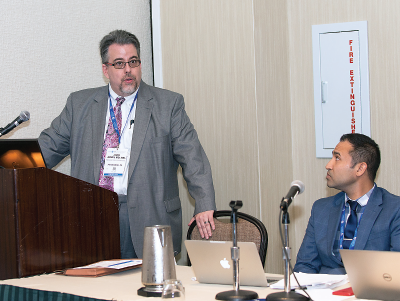“Prediction is very difficult, especially about the future.” —Niels Bohr, Danish physicist (1885-1962)
Focusing on identifiable and modifiable risk factors for violence, seeking out consultation with colleagues, and relying on patient family support are useful tools for assessing and managing patients at risk for violence.
So said a panel of experts on violence risk assessment at a workshop at IPS: The Mental Health Services Conference in New Orleans in October. They included John Rozel, M.D., an associate professor of psychiatry and adjunct professor of law at the University of Pittsburgh School of Medicine; Abhishek Jain, M.D., a forensic psychiatrist and research fellow at Columbia University and the New York State Psychiatric Institute; and Layla Soliman, M.D., an inpatient psychiatrist with the Carolinas Health System in Charlotte, N.C. The workshop was presented in collaboration with the American Association for Emergency Psychiatry.
Because there is no foolproof way to predict patient violence, clinicians should also be prepared to grieve and to reach out to colleagues for support when adverse events do occur. “We have this belief that [adverse events including violence] won’t happen if we do everything right, and we don’t get emotional because we are physicians,” Soliman said.
The clinical work of assessing violence risk and taking steps to mitigate that risk is about minimizing the chance of violence, not about eliminating it as a possibility, she pointed out. She added that she has experienced adverse events in her work and has taken comfort in knowing “I did what I could.”
All three speakers emphasized that the vast majority of violence is not attributable to mental illness and that patients with mental illness are, in fact, more likely to be victims of violence.
Jain said one difficulty of predicting who might be violent can be illustrated statistically in what is known as the “low base rate” problem, common to studying low frequency events, such as some categories of violence.
Calculating on the basis of FBI estimates of 372 violent crimes per 100,000 people in 2015, Jain explained that even a somewhat high-quality test instrument for violence risk with 85 percent sensitivity and 90 percent specificity may yield a total of more than 10,000 false negatives and positives.
He said research on violence risk assessment has evolved from one of unaided clinical judgment to “actuarial prediction” using various kinds of rating instruments and to what is called today “structured clinical judgement.” The latter is a formalized approach that incorporates clinical judgment but draws on evidence-based risk and protective factors with an emphasis not merely on assessment of risk but on prevention and management.
Structured clinical judgment typically involves the following critical tasks: collecting data, identifying risk factors, prioritizing risk factors, developing scenarios for possible enactment of violence, formulating a plan for managing the risk, communicating the risk when necessary, and documenting the steps in the process.
Rozel described the evolution of Multidisciplinary Threat Management Teams that use a case management approach, merging behavioral science, law enforcement, and operational leadership. He said Threat Management Teams have evolved as the assessment and management of risk have grown more complex, engaging issues of privacy and confidentiality, involuntary commitment, clinician duty to warn third parties, and Constitutional rights of free speech and gun ownership.
Soliman outlined the challenges of assessing and managing risk among patients with psychotic illness, emphasizing that history of violence and factors such as domestic violence and substance use are more predictive of future violence than psychosis alone (see box for major risk factors for violence).
However, several factors do increase the risk of violence among patients with psychosis. These include nonadherence to treatment, lack of insight, positive symptoms including hallucinations and delusions, and poor impulse control. Soliman said foundational research on violence risk has emphasized the presence of command hallucinations and persecutory delusions, but newer research focuses on history—recent arrests, past assaultive behavior, patterns of rule breaking, and/or past suicide attempts—and current affect (is the patient hostile and/or aggressive?).
Soliman said risk assessment and formulation of strategies for management and risk mitigation in patients with psychosis should begin at the time of hospital admission or early in outpatient treatment.
“Risk assessment should not begin at discharge,” she said. She advised clinicians to “go where the money is” by targeting risk factors that are modifiable: substance use, positive psychotic symptoms, access to firearms, mood instability, homelessness, untreated or undertreated pain, and/or lack of coping skills. She recommended leveraging protective factors—the patient’s engagement in treatment, religious or spiritual beliefs, supportive family members, pets, and future goals.
Soliman especially emphasized the value of involving family. “My favorite intervention, with the biggest payoff, is family meetings,” Soliman said.
The other crucial strategy is to consult with colleagues and have the patient evaluated by another psychiatrist; patients are often more than willing to talk to a consulting psychiatrist, Soliman said.
“Psychiatrists tend to be lone rangers,” she said. “But as a forensic psychiatrist, I get asked to consult on cases regularly. This is one of the pillars of liability management—it’s a lot harder to say two doctors were mistaken [about violence risk] than one doctor.” ■

